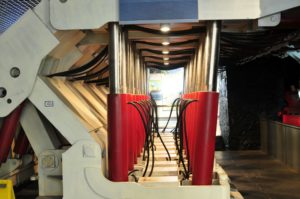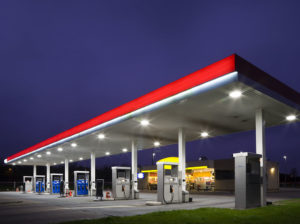Aircraft Hangars, typical risk include:
- Spill fires
- Aircraft maintenance activities include several potential ignition sources
- Large quantities of liquid jet fuel could present
Typical Requirements
- Shadow effect by the wings of the airplane should be considered.
- Big heights and distances.
- Combination of sufficient sensitivity, fast response and good resistivity to false alarms is needed.
- Only allowing unfueled aircraft will drastically lower the impact of a fire, but normally aircraft are fueled, for operations reasons.
- The floor area strongly varies from 500 m2 for small airplanes to 20000 m2 for the biggest commercial airplanes.
We recommend UV/IR or IR3 Flame Detectors
Car, Bus, Tram and Train Parkings, typical risks include:
- Ignition sources: lightning, static discharge, arson
- Several cars, buses, trams or rail cars are closely stored. This leads to serious risk of flash-over and makes both detection and repression difficult.
Typical Requirements
- Adapt positioning of the detectors to the potential shadow effect.
We recommend UV/IR or IR3 Flame Detectors
Chemical Plant Application
Chemical Industry is an application typically having several sub-applications, like tank parks, process equipment, tank truck loading and unloading, tank parks, pipe racks, laboratories with laboratory fume hoods. Often also terminal activities. Each of these subjects have their own fire risks. See other lemmas for the details on sub-applications.
We recommend, depending on the sub application IR3, UV/IR or UV Flame Detectors
Conveyor Belt Application
Conveyor belts move a wide variety of products. Often they are used for transport of combustible products. Conveyor belts can be found in many industrial applications. For example in bulk ports for unloading powdered material from vessels, in the recycling industry, steel plants and power plants. Sometimes the conveyor belts are enclosed, other times they are working in the open air.
Typical Risks Include:
- High risk of carrying burning material from one location to another. The movement of conveyor belt can highly spread the fire, as soon as the material on the belt is ignited. This requires fire detection with a quick response.
- Often conveyor belts are running in hardly accessible areas.
- Ignition may be caused by friction from misalignment of belts, overheating of motors, burning of material on the belts or hot work near the belt.
Typical Requirements
- When the to be transported material catches fire, it should be avoided that the goods on the conveyor belt reaches an (intermediate) storage, which would highly increase the damage on the fire. As long as the belt is running.
- The application is often dusty. The detector choice should be adapted to that.
We recommend IR3 Flame Detector
Engine Rooms Application
Engine rooms will typically, but not only be found on board of vessels (ship engine rooms), but also on shore in the industry. in case of an industrial application losses. In engine rooms typically open fires are to be expected.
Typical Risks:
- Ignition sources: Hot surfaces of the engine and the exhaust system with temperatures that exceed the auto ignition temperature of the fluids used in the engine.
Typical Requirements:
- Intense ventilation in the generator room.
- Obstruction of the sight in the engine room should we coped with.
- Hot surfaces may act as false alarm source.
- Especially for diesel engines: films on detector windows may act as an inhibitor.
We recommend for Diesel engine rooms IR3 Flame Detector, LPG Engine rooms IR3 or UV/IR Flame Detectors
Fumes Hoods
In laboratory fume hoods regularly endurance tests are taking place, in unmanned laboratories in the nights or in the weekend. On the other hand, several liquids and gases used, may be inflammable. Therefore Flame Detectors are recommended in this application.
Typical risks
Typical features for laboratory fume hoods are:
- A variety of Infrared false alarm sources may occur.
- High ventilation rates may occur.
- The housing of the Flame detector should be non-metallic.
- The Flame Detector should be compact.
- The Flame Detector should be mounted directly to the ceiling of the laboratory fume hood, without using a Swivel Mount.
- Mounting of the Flame Detector in the air flow of the fume hood should be avoided.
Detector choice: recommended UV only or UV/IR Flame Detectors. Optionally with a modified setting: a higher sensitivity, and a shorter response time.
Gas Service Stations
Application
Gas service stations are characterized by the fact that laymen are present in a hazardous area zone 2 / Div 2 but also zone 1, Div1.
Typical risks
Typical features for Gas service stations are:
- Ignition sources: static discharge, lighter, hot brakes or engines
- High ventilation rates may occur.
- Spill fires and fuel tank fire(because of imprudence)
- Fuel pumps should be monitored; flame detectors can be mounted below the roof
- Tank truck unloading and bulk fuel storage should be monitored
Typical requirements
- Pumps and drains should be monitored
- Tank truck unloading and storage tank area should be monitored
Detector choice: recommended IR3 or UV/IR Flame Detectors.
Generator Rooms
Generators are typically applied for backup or emergency purposes. This may be for safety systems such as in hospitals, or to avoid loss of productivity in case of an industrial application, losses by assurance of continuity. In generator rooms typically open fires are to be expected.
Typical Risks and properties
- Hot surfaces of the engine and the exhaust system may ignite Fuel and/or Lubricants.
- Obstructions in the generator room are potential inhibitors so use at least two Flame detectors. Use at least four Flame detectors when voting is applied.
- Oil films may inhibit the Flame Detector in Diesel Generator Rooms.
Typical Requirements
- Good false alarms immunity.
- Resistance to vibrations and shocks.
- High ventilation rates.
- Rugged Non-conductive housing material.
- Simple to install.
- Able to deal with temperature variations.
Detector choice: recommended UV/IR Flame Detectors for Gas Generator Rooms. Recommended IR3 Flame Detectors for Diesel Generator Rooms.
Hydraulics (Extruders)
Many industrial fires are caused by oil spray from a high pressure hydraulic fluid leak. The leak can create an atomized spray that may project up to 40 ft (12 m) from the release point. Pressurized sprays produce small droplets that are ignited at temperatures below the normal flash point.

TYPICAL Features
Typical features for hydraulics are:
- A variety of false alarm sources may occur.
- High ventilation rates may be present.
- Be sure to monitor the drainage areas.
- Sprinklers will have little effect on an oil spray fire but will at least cool the adjacent materials.
- Use the alarm signal of the flame detector for a shut-down of the high pressure pump.
Detector choice: recommended IR3 Flame Detectors.



